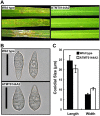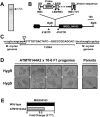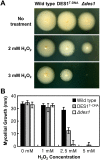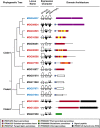A novel pathogenicity gene is required in the rice blast fungus to suppress the basal defenses of the host
- PMID: 19390617
- PMCID: PMC2668191
- DOI: 10.1371/journal.ppat.1000401
A novel pathogenicity gene is required in the rice blast fungus to suppress the basal defenses of the host
Abstract
For successful colonization and further reproduction in host plants, pathogens need to overcome the innate defenses of the plant. We demonstrate that a novel pathogenicity gene, DES1, in Magnaporthe oryzae regulates counter-defenses against host basal resistance. The DES1 gene was identified by screening for pathogenicity-defective mutants in a T-DNA insertional mutant library. Bioinformatic analysis revealed that this gene encodes a serine-rich protein that has unknown biochemical properties, and its homologs are strictly conserved in filamentous Ascomycetes. Targeted gene deletion of DES1 had no apparent effect on developmental morphogenesis, including vegetative growth, conidial germination, appressorium formation, and appressorium-mediated penetration. Conidial size of the mutant became smaller than that of the wild type, but the mutant displayed no defects on cell wall integrity. The Deltades1 mutant was hypersensitive to exogenous oxidative stress and the activity and transcription level of extracellular enzymes including peroxidases and laccases were severely decreased in the mutant. In addition, ferrous ion leakage was observed in the Deltades1 mutant. In the interaction with a susceptible rice cultivar, rice cells inoculated with the Deltades1 mutant exhibited strong defense responses accompanied by brown granules in primary infected cells, the accumulation of reactive oxygen species (ROS), the generation of autofluorescent materials, and PR gene induction in neighboring tissues. The Deltades1 mutant displayed a significant reduction in infectious hyphal extension, which caused a decrease in pathogenicity. Notably, the suppression of ROS generation by treatment with diphenyleneiodonium (DPI), an inhibitor of NADPH oxidases, resulted in a significant reduction in the defense responses in plant tissues challenged with the Deltades1 mutant. Furthermore, the Deltades1 mutant recovered its normal infectious growth in DPI-treated plant tissues. These results suggest that DES1 functions as a novel pathogenicity gene that regulates the activity of fungal proteins, compromising ROS-mediated plant defense.
Conflict of interest statement
The authors have declared that no competing interests exist.
Figures









Similar articles
-
The basic leucine zipper transcription factor Moatf1 mediates oxidative stress responses and is necessary for full virulence of the rice blast fungus Magnaporthe oryzae.Mol Plant Microbe Interact. 2010 Aug;23(8):1053-68. doi: 10.1094/MPMI-23-8-1053. Mol Plant Microbe Interact. 2010. PMID: 20615116
-
The bZIP transcription factor MoAP1 mediates the oxidative stress response and is critical for pathogenicity of the rice blast fungus Magnaporthe oryzae.PLoS Pathog. 2011 Feb;7(2):e1001302. doi: 10.1371/journal.ppat.1001302. Epub 2011 Feb 24. PLoS Pathog. 2011. PMID: 21383978 Free PMC article.
-
An S-(hydroxymethyl)glutathione dehydrogenase is involved in conidiation and full virulence in the rice blast fungus Magnaporthe oryzae.PLoS One. 2015 Mar 20;10(3):e0120627. doi: 10.1371/journal.pone.0120627. eCollection 2015. PLoS One. 2015. PMID: 25793615 Free PMC article.
-
Homeobox transcription factors are required for conidiation and appressorium development in the rice blast fungus Magnaporthe oryzae.PLoS Genet. 2009 Dec;5(12):e1000757. doi: 10.1371/journal.pgen.1000757. Epub 2009 Dec 4. PLoS Genet. 2009. PMID: 19997500 Free PMC article.
-
Every Coin Has Two Sides: Reactive Oxygen Species during Rice⁻Magnaporthe oryzae Interaction.Int J Mol Sci. 2019 Mar 8;20(5):1191. doi: 10.3390/ijms20051191. Int J Mol Sci. 2019. PMID: 30857220 Free PMC article. Review.
Cited by
-
Evidence for biotrophic lifestyle and biocontrol potential of dark septate endophyte Harpophora oryzae to rice blast disease.PLoS One. 2013 Apr 18;8(4):e61332. doi: 10.1371/journal.pone.0061332. Print 2013. PLoS One. 2013. PMID: 23637814 Free PMC article.
-
Different chitin synthase genes are required for various developmental and plant infection processes in the rice blast fungus Magnaporthe oryzae.PLoS Pathog. 2012 Feb;8(2):e1002526. doi: 10.1371/journal.ppat.1002526. Epub 2012 Feb 9. PLoS Pathog. 2012. PMID: 22346755 Free PMC article.
-
A two-component histidine kinase, MoSLN1, is required for cell wall integrity and pathogenicity of the rice blast fungus, Magnaporthe oryzae.Curr Genet. 2010 Dec;56(6):517-28. doi: 10.1007/s00294-010-0319-x. Epub 2010 Sep 17. Curr Genet. 2010. PMID: 20848286
-
ER retention receptor, MoERR1 is required for fungal development and pathogenicity in the rice blast fungus, Magnaporthe oryzae.Sci Rep. 2017 Apr 28;7(1):1259. doi: 10.1038/s41598-017-01237-x. Sci Rep. 2017. PMID: 28455525 Free PMC article.
-
Redox-sensitive GFP2: use of the genetically encoded biosensor of the redox status in the filamentous fungus Botrytis cinerea.Mol Plant Pathol. 2012 Oct;13(8):935-47. doi: 10.1111/j.1364-3703.2012.00802.x. Epub 2012 Apr 24. Mol Plant Pathol. 2012. PMID: 22524254 Free PMC article.
References
-
- Heath MC. Nonhost resistance and nonspecific plant defenses. Curr Opin Plant Biol. 2000;3:315–319. - PubMed
-
- Chisholm ST, Coaker G, Day B, Staskawicz BJ. Host-microbe interactions: shaping the evolution of the plant immune response. Cell. 2006;124:803–814. - PubMed
-
- Jones JD, Dangl JL. The plant immune system. Nature. 2006;444:323–329. - PubMed
-
- Gómez-Gómez L, Boller T. FLS2: an LRR receptor-like kinase involved in the perception of the bacterial elicitor flagellin in Arabidopsis. Mol Cell. 2000;5:1003–1011. - PubMed
-
- Felix G, Duran JD, Volko S, Boller T. Plants have a sensitive perception system for the most conserved domain of bacterial flagellin. Plant J. 1999;18:265–276. - PubMed
Publication types
MeSH terms
Substances
LinkOut - more resources
Full Text Sources
Research Materials

